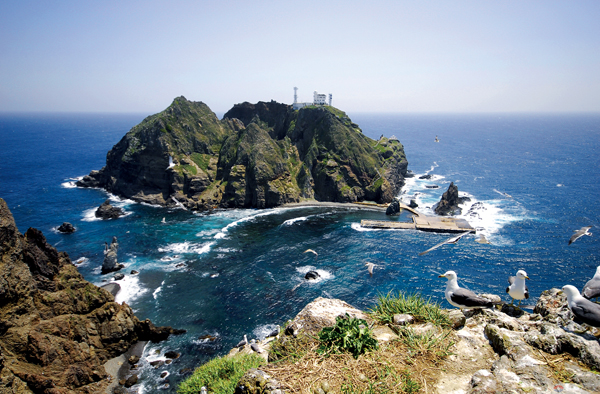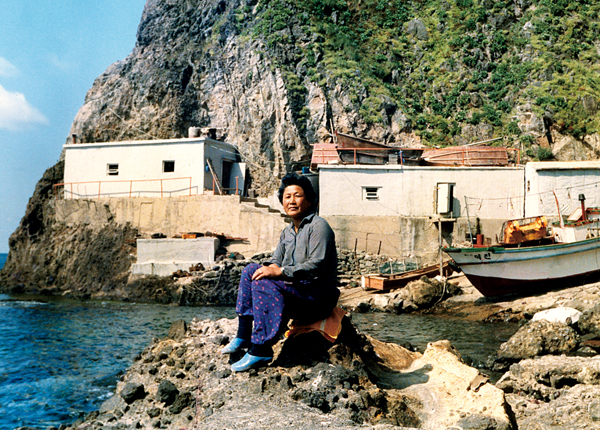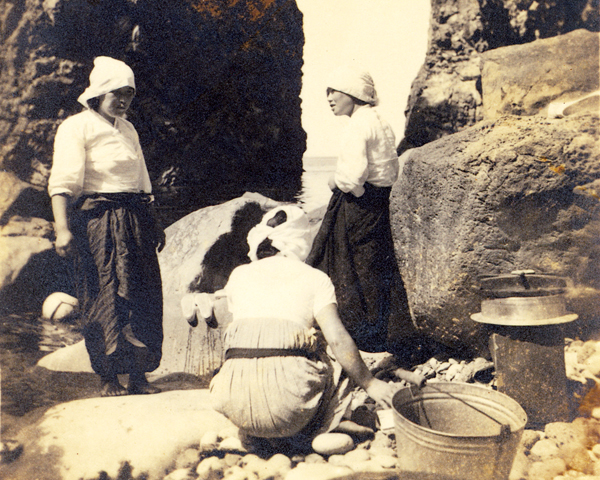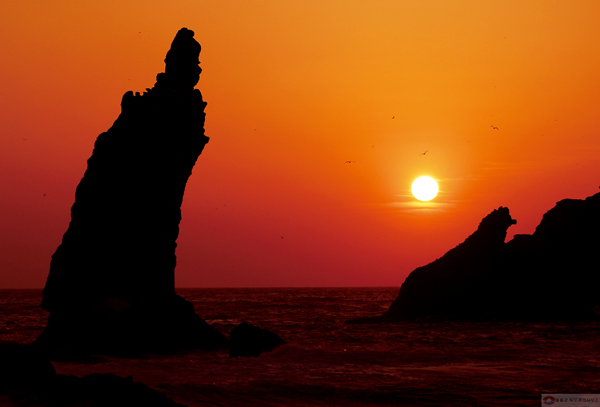
- Updated 2024.5.14 17:13
- All Articles
-
member
icon
-
facebook
cursor
-
twitter
cursor
| |
 |
|
| ▲ Dongdo, Dokdo's east island, seen from Seodo, the west island. All photos courtesy Jeju Haenyeo Museum |
The Jeju Haenyeo and Dokdo Exhibition on display at the Haenyeo Muse-um throughout July is not the display of beautifully photographed images that one is accustomed to seeing of the island’s famous diving women. Many of the shots are, in fact, of such poor quality that the enlarged version on display is grainy with vague rather than crisp outlines and few show any artistry in the composition or photography.
It is not for artistic reasons that these 17 photos are of value, however, but their documentary nature as a chronicle of an important part of the lives of many Jeju haenyeo. All the images are from the private collection of Goh Sun Ja – a former haenyeo who, now 75-years-old, lives in Jeju City. Goh spent time diving off the coast of Dokdo between 1973 and 1991 as one who harvested the disputed waters in groups of about 30 at a time .
The Dokdo Island group has long been an issue of contention between the Republic of Korea and Japan, which calls the islands Takeshima. Two Korean citizens reside on Dokdo to justify a claim of habitation and South Korean police are also stationed on the islands. Choa Hae Gyung, a researcher with the Haenyeo Museum, said the yearly visits by Jeju haenyeo from as early as 1953 also served to reinforce Korea’s claim on the group. Although the haenyeo first went to the islands for economic reasons, as the rich fishing ground offshore is one of many reasons the two countries dispute ownership, their presence there was also seen as a patriotic act.
| |
 |
|
| ▲ Goh Sun Ja resting after a day of diving in the 1980s |
The South Korean government considers Dokdo part of Ulleung County and the waters are overseen by the Ulleungdo oeucheongae, or fishing village cooperative. Jeju haenyeo had to register with the oeucheongae to work on Dokdo for a minimum of 90 days per stay, and rights could be passed down to family members or sold.
“Many Jeju haenyeo went to Dokdo in the 1970s because the area was rich in seaweed,” Choa said, “but then seaweed began being farmed. These days, divers [using breathing equipment] have replaced haenyeo to dive for abalone and sea products off Dokdo.”
| |
 |
|
| ▲ Haenyeo preparing to dive from Ulleungdo in the late 1950s |
Here on Jeju, only haenyeo can harvest the coastline commercially, Choa said, but of the 5,000 Jeju haenyeo currently registered, 75 percent are aged 60 to 70. In the next 10 years, the haenyeo culture will drastically change.”
It is vitally important for those older women to pass on their knowledge in order to continue the culture, she said. “Haenyeo are not only an essential part of Jeju culture, but also play an important role in caring for the environment and the sea.”
| |
 |
|
| ▲ Sunrise from Dongdo |
|
|
|
|
|
|
|
|
|
|
|
ⓒ Jeju Weekly 2009 (http://www.jejuweekly.net)
All materials on this site are protected under the Korean Copyright Law and may not be reproduced, distributed, transmitted, displayed, published without the prior consent of Jeju Weekly. |
|
|
|
|
| Jeju-Asia's No.1 for Cruise |
|
|
|
Title:The jeju Weekly(제주위클리) | Mail to editor@jejuweekly.net | Phone: +82-64-724-7776 Fax: +82-64-724-7796
#503, 36-1, Seogwang-ro, Jeju-si, Jeju-do, Korea, 63148
Registration Number: Jeju, Ah01158(제주,아01158) | Date of Registration: November 10,2022 | Publisher&Editor : Hee Tak Ko | Youth policy: Hee Tak Ko
Copyright ⓒ 2009 All materials on this site are protected under the Korean Copyright Law and may not be reproduced, distributed, transmitted, displayed, published
without the prior consent of jeju weekly.com.

|























